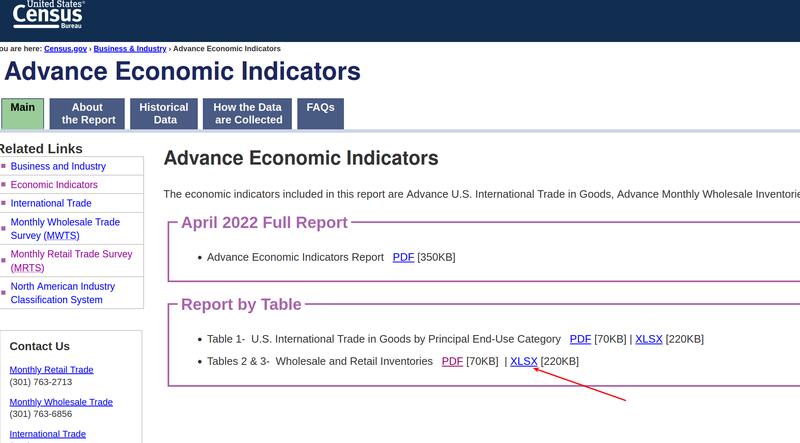“The economy is going to collapse.” Well, a Good Morning to you, too, dear reader! Always nice to read something like that, right? And who said it? That was Michael Novogratz, a “veteran investor and bitcoin bull”, talking with MarketWatch. He is convinced a “fast recession” is coming.
Well, everyone has an opinion so someone is bound to have said basically anything. Here, it’s much more interesting to look at why Novogratz thinks that a recession is coming. Here are his reasons:
- “Housing is starting to roll over”
- “Inventories have exploded.”
- “There are layoffs in multiple industries”
- the Fed will have to “hike [interest rates] until inflation rolls over.”
We can have full discussions on any of these points, but what caught my eye was the inventory bit. That can be indeed worrisome, and I’ll discuss later why.
But first … didn’t we have supply chain issues all over? Shouldn’t companies have dangerously low inventory levels?
Let’s find out.
Does the US retail industry have excessive inventory levels?
The MarketWatch article was a bit low on details, so I looked around and the inventory levels people were worried about seemed to be around furniture, electronics, microwaves, that kind of stuff. So I dug around a bit, and it turns out Novogratz is correct: Various retailers reported too much inventory on hand! I picked out a few examples for you: Walmart, Target, Macy's, but the list goes on.
But … that’s still just a handful of companies—maybe it’s not an industry-wide issue? Where is the aggregate data?
Turns out the U.S. Census Bureau publishes those statistics. I was looking at data for retailers that sell furniture, home furniture, electronics, and appliances. One interesting data set they publish is how inventory changes relative to sales. If the number rises it means that stuff piles up. If the number shrinks inventory shrinks down as stuff sells out.
And yeah, by that metric, the retailers really are clogging up. In the months of March and April the ration was 1.65 and 1.62. Wow, amazing! But what does that mean? These numbers only make sense when you compare them to before.
So let’s look at last year. The highest number there was 1.55, the median was 1.33. Okay, fine, 2021 was the year of supply chain mess, where the giant containership Evergiven got stuck, and so on. So what about 2019, the year before the pandemic?
2019 the highest ratio was 1.65 and the median was 1.56.
2018? 1.61 was the highest, 1.56 the median.
Where do you get the actual retail inventory data for the US?
All this data, where does it come from? Where can you check yourself? Sure, there are aggregator websites, but where do they get it from?
I got the above numbers from a report published by the US Census Bure, specifically:
U.S. Census Bureau; Advance Economic Indicators Report, May 27, 2022.
You can find the Advance Economic Indicators reports here. Go down to “Report by Table”, then download the Excel spreadsheet under the “XLSX” link.

Each year has a tab. In each, you find the numbers we’ve discussed above under “INVENTORIES/SALES, RATIOS ADJUSTED”.
So, we now had already two months where inventory levels are huge—as much as the highest point in previous years. So Novogratz is right to point those out.
But why is that worrisome? And does this mean a recession is coming?
Why too much inventory can indicate a recession
Rising inventory levels can be worrisome but don’t need to be. The question is why inventory levels are rising (if they do).
If they indicate that pepple are spending less and less then that could indicate trouble ahead. People might spend less because they’ve got less money to spend (inflation!) or because they’re worried and prefer to save up for tough times ahead.
In that case, that might be exactly the kind of thing that triggers a recession. Quick reminder: recessions are downturns that get worse and worse—and consumers spending less is usually how it starts.
But … is that the case? Are consumers spending less? Turns out: nope.
Other reasons for high inventory levels
A Wall Street Journal article nails the problem in its headline:
Stores Are Stocked Like We’re All Still Working From Home
As the retailers emphasize in their reports, inventories pile up because they’ve got the wrong things! As the pandemic measures have come to a close in many countries, people go out again. They go shopping again, and they shop for different things.
For example cloths: the Zoom-times sweatpants are out, now people go out and want to dress up nicely. Or they need some formal attire for the office again. People aren’t stuck at home anymome, so less money on appliances and anything for the house—more money for the barber and other services.
Macy's stock actually surged because they expect good profits ahead. So while, yes, there is lots of excess inventory and it needs to be cleared out with discounts that doesn’t mean that people spend less; they might just spend it on different things.
So, is the (US) economy out of the woods? No. Only that stuff piling up in retailer’s warehouses doesn’t seem to indicate a recession just yet.
